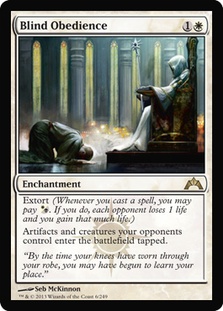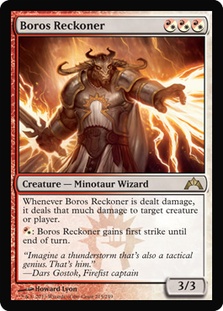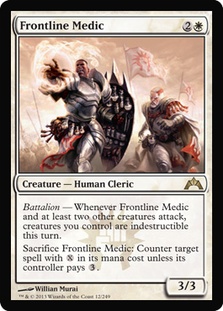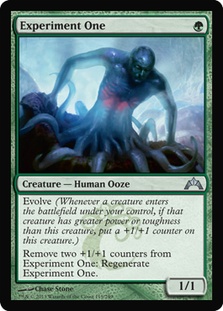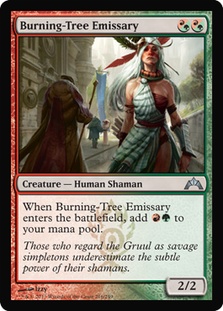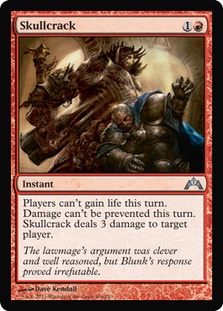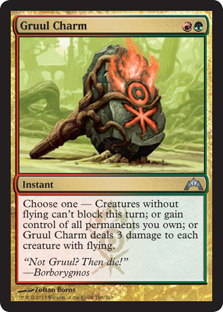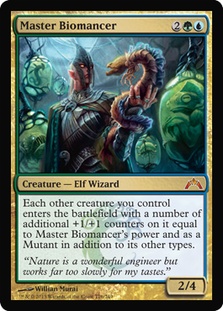Hello! The first major tournament with Gatecrash took place this past weekend and provided a ton of different ideas for those of you who are going to play Standard in the upcoming weeks at Pro Tour Gatecrash, SCG Standard Open: Edison, or at SCG IQs and FNMs all over the world. Many new cards and strategies proved themselves, and some didn’t. Let’s take a look at the results of SCG Standard Open: Atlanta.
The Top 32 decks include sixteen different archetypes (and some playable decks didn’t make it!) with Jund Midrange and Naya Midrange at the top with six and five copies respectively. As expected, the most important Gatecrash addition at the early stage of the new format is shocklands. The most popular deck (Jund Midrange) typically included zero to two new nonland cards (Devour Flesh). Naya Midrange gained Aurelia, the Warleader but didn’t include anything new aside from the Boros angel and one-to-two copies of Domri Rade (who, according to Saturday’s coverage, was the most disappointing new card).
Besides introducing new cards, Gatecrash also made the best archetypes more reliable, driving the metagame to stagnation and innovation simultaneously. The most innovative decks from the Top 32 of Atlanta included more than ten new nonland cards maindeck, and two of them were brand new archetypes! Eddie Walker made Top 8 with Esper Spirits, refreshing and rebuilding the old Pro Tour Dark Ascension deck, and Marsh Usary placed 19th with BUG Tempo.
Creatures (18)
Lands (24)
Spells (18)
Sideboard

There is nothing comparable to Phantasmal Image in Standard (although I’d try one or two copies of Evil Twin in the sideboard), so Eddie just put the five best Spirits together. The mana curve of his creation is horrible (that’s what kept the deck from being playable earlier), but eleven cheap removal spells help it survive long enough.
The most interesting thing about this list is the combination of Blind Obedience and Dungeon Geists. Aggressive, hasty decks will probably rise to the top to beat midrange decks. Blind Obedience is a fine way to beat Hellrider, Strangleroot Geist, and Thundermaw Hellkite, so this card probably already overperformed my expectations and would be fine in both Esper Control variants and U/W/R Flash.
Creatures (16)
Lands (20)
Spells (24)
Sideboard

I’m a huge fan of this deck regardless of whether it’s bad or good because it represents the idea of tempo in such an elegant way. It has 24 spells to flip Delver of Secrets and all kinds of removal to clear the way. Nevertheless, the BUG color combination has some significant problems, like the inability to deal with Olivia Voldaren (that’s why I’d play two or three Tragic Slip here or maybe sideboard Plummet for Olivia, Angel of Serenity, and Aurelia), but it still looks very interesting. One last note: this deck is a fine home for Quirion Dryad, especially if the metagame becomes more aggressive.
The next interesting and overperforming card technically isn’t new, but it never saw Constructed play before Stomping Ground came to Standard. Flinthoof Boar is the newest addition to a wide selection of good three-mana creatures: Centaur Healer, Loxodon Smiter, Izzet Staticaster, Dreg Mangler, Silverblade Paladin, Geist of Saint Traft, Vampire Nighthawk, Pyreheart Wolf… Two other newcomers (Boros Reckoner and Frontline Medic) also proved themselves. Flinthoof Boar and Boros Reckoner have a similarity in their restrictive costs—both are good only in red-based decks since green-based ones include significant amounts of basic Forests to support mana dorks.
What’s the minimum amount of Mountains to make Flinthoof Boar good enough? I’d guess ten, and you’ll have to be fine with a 2/2 from time to time, like it was in one of Saturday’s feature matches where a player topdecked Zealous Conscripts to attack for exactsies until the opponent pointed out that the land in the middle of his pile was Clifftop Retreat, not Sacred Foundry. There are not that many good two-mana creatures, so combining Flinthoof Boar with Strangleroot Geist in a three-colored deck with eight or nine Mountains would fine—like Tyler Lindsey did in his Top 4 deck.
Creatures (28)
- 4 Strangleroot Geist
- 4 Hellrider
- 2 Thundermaw Hellkite
- 3 Flinthoof Boar
- 4 Dreg Mangler
- 3 Deathrite Shaman
- 4 Experiment One
- 4 Ghor-Clan Rampager
Lands (24)
Spells (8)

This list has all the tools to make Experiment One a 3/3 and enough Mountains to cast Hellrider on time, which was one of the most important problems of three-colored Hellrider decks. I’m not sure if the powerful Deathrite Shaman is good enough for the maindeck; I’d rather play Arbor Elf in its place to make good draws even faster, which is the key for beating midrange with this deck.
Also note that this deck can be hurt by Blind Obedience, so that’s a reason to prefer Jund colors to the more stable Gruul—Abrupt Decay is so much better than Naturalize. Aside from that, Gruul exchanges better quality creatures for much more explosive draws powered by another newcomer: Burning-Tree Emissary. Combined with Lightning Mauler, Gore-House Chainwalker, and Flinthoof Boar, this version Grizzly Bears may be utterly devastating.
Creatures (28)
- 4 Stromkirk Noble
- 4 Hellrider
- 4 Lightning Mauler
- 4 Flinthoof Boar
- 4 Rakdos Cackler
- 4 Burning-Tree Emissary
- 4 Ghor-Clan Rampager
Lands (23)
Spells (10)
Sideboard

What I dislike in both of these lists is the lack of Zealous Conscripts in the 75. As fast as you are aiming to be, Huntmaster of the Fells and Thragtusk are not to be underestimated, and there should be some way to turn the game around after the opponent has stabilized. Pyreheart Wolf is there to prevent this situation, but it’s unlikely to fit in multicolored decks (and even Mono-Red because of Boros Reckoner). Skullcrack and Gruul Charm may be helpful, but Zealous Conscripts has the most blowout potential.
As I said, Boros Reckoner is the creature that ousts Pyreheart Wolf from Mono-Red Aggro, and it’s hard to imagine this undoubtedly powerful creature somewhere else. His mana cost is hard for Forest decks to deal with, his creature types don’t help Cavern of Souls decks, and there are no white-based decks to use him. So the question is if Boros Reckoner is good enough to be a good midgame topdeck for midrange decks or if he’ll be just a great creature for Mono-Red decks.
Creatures (28)
- 4 Stromkirk Noble
- 4 Hellrider
- 2 Stonewright
- 4 Lightning Mauler
- 2 Thundermaw Hellkite
- 4 Ash Zealot
- 4 Rakdos Cackler
- 4 Boros Reckoner
Lands (22)
Spells (10)

As for this particular list, used by Ryan Cruz to place 9th in Atlanta, I’d swap two Stonewright for a pair of Pyreheart Wolves, but I’m fine with the rest. And Andrew Schneider Top 4 deck proves that all Mountains is actually better than Boros; Andrew was unable to even fit the full four Boros Charms into his list! Boros Guildgate is not for Mono-Red Aggro, so Naya decks support multiple white sources for Boros Charm better than true Boros decks.
Aaaand the winner was Joseph Herrera and his Naya Humans deck! Joseph didn’t taste a single defeat during the whole tournament and won an awesome all-Humans final. However, those two decks share only one creature—Huntmaster of the Fells—as Joseph was straight aggro while his opponent, Brian Braun-Duin, played Human Reanimator powered by Cartel Aristocrat. With this fine new addition, all the combo pieces can be Reanimated with Angel of Glory’s Rise, which makes the deck true combo since it can gain infinite life.
Creatures (17)
- 4 Fiend Hunter
- 4 Huntmaster of the Fells
- 4 Angel of Glory's Rise
- 1 Cathedral Sanctifier
- 4 Cartel Aristocrat
Lands (23)
Spells (20)

I will not talk about this deck in detail since I’m sure Brian and Brad Nelson will cover it soon. The point I want to emphasize is that Human Reanimator is very weak to dedicated hate (and other Reanimator decks too) and doesn’t really play well against U/W/R Flash. So I don’t expect it to be constantly good, but I nearly worship Brad Nelson hilarious ability to crack the metagame. Does anyone play Hoof There It Is these days? No, but it was built just in time to win a Grand Prix. So Human Reanimator may not be the best deck in the world, but it was great for this past weekend. Keep it mind because it might be great again sometime in the future!
Creatures (31)
- 4 Champion of the Parish
- 4 Avacyn's Pilgrim
- 4 Mayor of Avabruck
- 3 Thalia, Guardian of Thraben
- 3 Huntmaster of the Fells
- 3 Restoration Angel
- 4 Silverblade Paladin
- 3 Nearheath Pilgrim
- 3 Frontline Medic
Lands (23)
Spells (6)

Naya Humans gained the great Frontline Medic and Experiment One…oops! The lack of Human Ooze is the secret for me. Joseph’s deck has seven creatures to pump Experiment to 3/3, which is in my opinion enough to justify playing it. I was also curious about the set of two-mana creatures; Lightning Mauler would be good here, while Nearheath Pilgrim is only fine in a super-aggressive metagame (which Atlanta’s wasn’t). However, Joseph Herrera won the title without a single loss, so his actual choices should be investigated in detail (which I obviously didn’t due to lack of time).
Which decks are also worth considering despite not being represented in the Top 32 of SCG Standard Open: Atlanta? This tournament was very important for the upcoming format (maybe even more than Pro Tour Gatecrash itself), but that wasn’t any kind of restriction. Zan Syed made Top 8 with Four-Color Tokens, proving that Lingering Souls and Intangible Virtue can be paired with any cards now. Zan chose Huntmaster of the Fells since it’s one of the most powerful token generators in Standard; other options include Master Biomancer, who can make every Spirit real threat.
I’ve also seen Master Biomancer combined with Huntmaster of the Fells and Ghor-Clan Rampager, but I guess that such a combination isn’t aggressive enough to be better than other dedicated beatdown cards and isn’t powerful enough to be better than decks with Rakdos’s Return or Sphinx’s Revelation. However, Master Biomancer is definitely powerful and is waiting for someone to break the format with him.
One more deadly card combination is Restoration Angel plus Geralf’s Messenger. Zombies had hard time in Atlanta, but that doesn’t mean that this strategy is bad—Geralf’s Messenger is still one of the best cards in the format. Better mana, Obzedat, Ghost Council, and Cartel Aristocrat are fine arguments for Orzhov Zombies, but they could also be in non-Zombies midrange. Zombies could go back to red as well since no one has cancelled the power of Messenger supported by Falkenrath Aristocrat and Searing Spear.
Gatecrash introduced many interesting cards and strategies, making Standard even more interesting than it was. Will the next weekend bring something new? Surely! The SCG Standard Open in Edison and SCG Classic Series in Memphis are tournaments to participate in and watch for the next brew to make it to the top.

